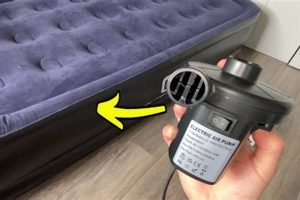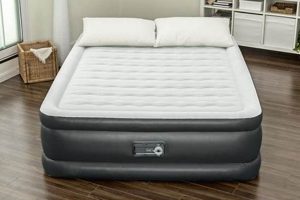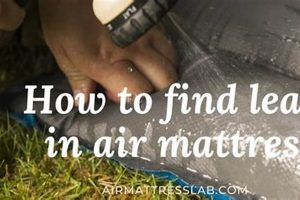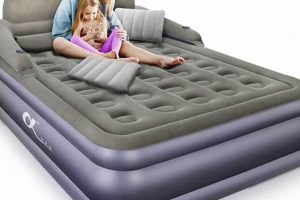The process of neatly collapsing and storing an inflatable sleeping surface involves several key steps. Deflation, typically achieved through a valve, precedes the physical manipulation of the material. Reducing the mattress’s volume is the primary goal, facilitating easier storage and transportation. One method includes pressing down to expel remaining air, followed by a series of folds or rolls to create a compact form.
Efficiently managing inflatable sleeping surfaces provides several advantages. It minimizes storage space requirements, particularly valuable in limited-area living situations. Proper execution extends the lifespan of the product by reducing stress on the material and seams, mitigating potential damage. Historically, the need for portable and comfortable sleeping solutions has driven innovations in inflatable mattress design and folding techniques.
Subsequent sections will detail specific methodologies for achieving optimal compactness, addressing variations in mattress construction and material. Furthermore, strategies for maintaining the integrity of the mattress during the compaction process will be examined. Factors influencing the choice of folding versus rolling methods will also be discussed.
Air Mattress Folding
Effective compaction of inflatable sleeping surfaces requires attention to detail and a systematic approach. The following guidelines are intended to maximize space savings and minimize potential damage during storage.
Tip 1: Maximize Deflation. Complete deflation is paramount. Utilize the mattress’s valve and apply pressure to expedite air expulsion. A vacuum cleaner attachment, used cautiously, can further reduce remaining air.
Tip 2: Choose Appropriate Surface. Perform the procedure on a clean, smooth surface to prevent punctures or abrasions. Avoid areas with sharp objects or excessive dust.
Tip 3: Employ a Folding Method. For rectangular mattresses, a tri-fold technique folding in thirds lengthwise is often optimal. For irregular shapes, adapt the folding pattern to minimize bulk.
Tip 4: Secure the Fold. Use straps, bungee cords, or the mattress’s integrated storage bag to maintain the compacted form. This prevents unfolding during storage and transport.
Tip 5: Avoid Sharp Creases. Folding should be performed smoothly to prevent permanent creases in the material. These creases can weaken the material and lead to air leaks over time.
Tip 6: Consider Rolling. In some cases, rolling the deflated mattress may be more efficient than folding, especially for thicker models. Ensure the roll is tight and evenly distributed.
Tip 7: Store in a Controlled Environment. After compaction, store the mattress in a dry, temperature-stable location. Avoid exposure to extreme heat or cold, which can degrade the material.
Adhering to these guidelines ensures efficient storage and prolonged product lifespan. Proper handling during the compaction phase minimizes the risk of damage and preserves the mattress’s functionality.
The subsequent discussion will address troubleshooting common challenges encountered during compaction and storage, providing solutions for maintaining optimal condition.
1. Deflation Completeness
Deflation completeness represents a critical precursor to successful compaction. Achieving maximum air removal directly influences the final dimensions and overall manageability of the deflated unit. Incomplete deflation complicates subsequent folding or rolling procedures and can compromise long-term storage efficiency.
- Volume Reduction Efficiency
The primary role of thorough deflation is to minimize the overall volume of the mattress. Greater air expulsion equates to a smaller final package. For instance, a mattress with residual air might occupy twice the space of a fully deflated counterpart. This directly impacts storage capacity in closets, vehicles, or other confined areas.
- Material Stress Reduction
Residual air trapped within the mattress during folding or rolling can create undue stress on the material seams and welds. This internal pressure, exacerbated by tight folding, can lead to premature material fatigue and eventual air leaks. Complete deflation minimizes this stress, contributing to extended product lifespan.
- Ease of Manipulation
A fully deflated mattress is significantly more pliable and easier to manipulate. This enhanced flexibility simplifies the folding or rolling process, allowing for tighter, more uniform compaction. Conversely, a mattress retaining air resists compression and creates uneven folds, increasing the likelihood of damage.
- Prevention of Mold and Mildew Growth
Residual moisture, often present within inflatable mattresses, can become trapped in pockets of stagnant air if deflation is incomplete. This creates a conducive environment for mold and mildew growth, particularly in humid conditions. Complete deflation promotes air circulation and reduces the risk of such microbial contamination.
The interconnectedness of these facets underscores the importance of prioritizing complete deflation prior to any attempts at folding or rolling. Neglecting this preliminary step can undermine storage efficiency, compromise material integrity, and increase the potential for long-term product degradation. The overall success of compaction hinges upon effective air removal.
2. Surface Cleanliness
The cleanliness of the surface upon which an inflatable mattress is compacted directly impacts the integrity and longevity of the product. A contaminated surface introduces particulate matter, including dust, dirt, and potentially sharp debris, which can compromise the mattress material during the folding or rolling process. The resulting abrasion and potential punctures degrade the air-retention capability, shortening the lifespan of the mattress. For example, folding a mattress on a garage floor with embedded metal shavings risks creating microscopic tears that gradually enlarge with use, leading to air leaks.
Furthermore, surface contaminants can adhere to the mattress material, promoting the growth of mold and mildew, especially when the mattress is stored in a humid environment. Organic matter, such as spilled food or pet dander, provides a nutrient source for these microorganisms. This growth not only creates unpleasant odors but also deteriorates the structural components of the mattress. Consider the common scenario of folding a mattress on outdoor carpeting; the trapped moisture and organic debris significantly increase the risk of microbial proliferation within the mattress’s interior.
In conclusion, maintaining a clean folding surface is not merely a matter of aesthetics but a crucial step in preserving the functionality and hygiene of the inflatable sleep
ing surface. Addressing this component prevents physical damage from debris and inhibits microbial growth from organic matter, thereby enhancing the overall quality and durability of the product. The challenges associated with this step are minimal, typically requiring only a quick sweep or wipe of the intended area, yet the benefits for product preservation are substantial.
3. Folding technique
The methodology employed to compact an inflatable mattress directly influences its stored volume, susceptibility to damage, and ease of subsequent deployment. A deliberate approach to folding optimizes these factors, extending the usable lifespan of the product.
- Tri-Folding Efficiency
The tri-fold technique, involving two lengthwise folds to create three roughly equal sections, proves efficient for rectangular mattresses. This method distributes stress evenly across the material, minimizing localized points of pressure that could lead to leaks. For example, a queen-sized air mattress, when tri-folded, achieves a more compact and manageable form factor compared to arbitrary folding methods, streamlining storage and transport.
- Rolling Optimization
An alternative to folding involves tightly rolling the deflated mattress from one end to the other. This technique excels when minimizing the final diameter of the stored unit. However, careful attention must be paid to prevent sharp creases from forming during the rolling process. Imagine a thick, high-pile air mattress; rolling, when executed precisely, yields a more streamlined cylindrical shape than a haphazardly folded form.
- Valve Placement Considerations
Effective folding strategies account for the placement of the inflation/deflation valve. Positioning the valve near the final point of folding or rolling facilitates the expulsion of any remaining air, further reducing the overall volume. Picture a scenario where the valve is inadvertently trapped within multiple layers of the folded mattress; the resulting air pockets impede full compression and complicate storage.
- Material-Specific Adaptations
Different air mattress materials necessitate tailored folding approaches. Thicker, more rigid materials may require gentler, wider folds to prevent cracking or seam separation. Conversely, thinner, more pliable materials can withstand tighter, more complex folding patterns. An example of this involves a heavy-duty, puncture-resistant mattress, which is best folded with broad, smooth movements, as opposed to sharp, angular creases that would stress the material.
These multifaceted considerations highlight the integral relationship between technique and overall effectiveness of air mattress compaction. A strategic approach, informed by the mattress’s design and material composition, directly impacts storage efficiency and product longevity. Mastery of these techniques mitigates potential damage and optimizes the usability of inflatable sleeping surfaces.
4. Securement method
The securement method employed following the compaction of an inflatable mattress directly dictates the stability and longevity of the folded or rolled unit. Effective securement prevents unintended unfolding, minimizes stress on the compressed material, and facilitates ease of handling and storage.
- Retention of Compacted Form
The primary role of securement is to maintain the reduced volume achieved through folding or rolling. Without adequate restraint, the inherent elasticity of the mattress material will cause it to gradually expand, negating the benefits of compaction. For instance, a loosely folded mattress stored in a confined space will exert pressure against surrounding objects, potentially leading to damage to both the mattress and the storage environment. In contrast, a securely strapped mattress retains its compact form, maximizing available space and minimizing the risk of unintended unfolding.
- Stress Distribution and Material Preservation
Proper securement distributes compressive forces evenly across the folded or rolled mattress. This prevents localized stress concentrations that can lead to material fatigue, seam separation, and air leaks. Consider the example of a mattress secured with a single, tightly cinched strap; the concentrated pressure at the strap’s location may cause premature wear or even puncture the material over time. Uniform securement, achieved through multiple straps or a fitted storage bag, mitigates this risk, extending the lifespan of the inflatable sleeping surface.
- Enhancement of Portability and Handling
A securely fastened, compacted mattress is significantly easier to handle and transport. Straps or a fitted bag provide a secure grip and prevent the mattress from shifting or unfolding during movement. The absence of securement results in a cumbersome, unwieldy package that is difficult to manage, increasing the likelihood of accidental drops or damage. Securing a compacted air mattress transforms it from a floppy, awkward object into a manageable unit.
- Protection Against Environmental Factors
Certain securement methods, such as the use of a fitted storage bag, offer additional protection against environmental factors such as dust, moisture, and pests. These elements can degrade the mattress material and compromise its hygiene. A sealed storage bag shields the mattress from these threats, preserving its cleanliness and extending its usable life. This benefit is particularly relevant for mattresses stored in garages, attics, or other less-than-ideal environments.
The effectiveness of air mattress folding is contingent upon the subsequent securement. The securement strategy impacts overall space efficiency, material integrity, handling ease, and protection from environmental damage. Prioritizing appropriate securement methods ensures the investment in an inflatable sleeping surface yields sustained benefits.
5. Crease avoidance
Minimizing the formation of sharp creases during inflatable mattress folding represents a critical factor in preserving material integrity and extending product lifespan. Creases, particularly those of significant depth or sharpness, act as stress concentrators, accelerating material fatigue and increasing the likelihood of air leaks. The correlation between conscientious folding practices and the prevention of crease formation is, therefore, directly proportional to the overall durability of the mattress.
- Localized Stress Amplification
Sharp creases introduce points of high stress concentration within the mattress material. The compressive forces exerted during storage are focused at these crease lines, exceeding the material’s tensile strength and leading to microscopic damage. Over time, these micro-fractures coalesce, forming larger cracks that compromise the air-tight seal. A common example involves repeatedly folding a mattress along the same line, resulting in a permanent crease that eventually ruptures with subsequent use. The implication is clear: avoiding concentrated stress through careful folding minimizes the
risk of material failure. - Seam Integrity Compromise
Creases positioned near seams, where multiple layers of material are joined, present a particularly acute vulnerability. The added thickness at the seam exacerbates the stress concentration, predisposing the seam to separation or tearing. Visualize an air mattress with a perimeter seam subjected to repeated sharp folds; the seam’s adhesive bond weakens, leading to air leaks and rendering the mattress unusable. Careful folding techniques that avoid stressing the seams are, therefore, essential for maintaining structural integrity.
- Material Degradation Acceleration
Crease formation accelerates the degradation of the mattress material through processes such as plasticizer migration and ozone cracking. Sharp folds disrupt the polymer structure, allowing plasticizers (additives that impart flexibility) to leach out, rendering the material brittle and prone to cracking. Additionally, the stressed material is more susceptible to ozone attack, a common environmental factor that degrades rubber and plastics. The result is premature aging and reduced resistance to punctures and abrasions. Gentle, rounded folds, in contrast, minimize these degradative effects.
- Impact on Repairability
The presence of deep, permanent creases complicates subsequent repair efforts. Patching or sealing a crease-damaged area is significantly more challenging than repairing a smooth, undamaged surface. The irregular topography of the crease makes it difficult to achieve a reliable seal, and the underlying stress may cause the patch to fail prematurely. An air mattress meticulously folded to avoid creases presents a much more favorable surface for repairs, increasing the likelihood of a successful and long-lasting fix. It has a large impact on the material repairability
In summary, the avoidance of sharp creases during inflatable mattress folding constitutes a proactive strategy for preserving the mattress’s structural integrity and extending its functional lifespan. By distributing stress evenly, protecting seams, minimizing material degradation, and facilitating potential repairs, conscientious folding practices directly contribute to the long-term value and usability of the product. Therefor, consideration of material type is very important.
6. Environment control
Environmental management during the storage of inflatable mattresses directly affects their condition and longevity. The parameters of temperature, humidity, light exposure, and pest control constitute key environmental factors demanding careful consideration. Suboptimal conditions accelerate material degradation, compromise structural integrity, and shorten the functional lifespan of the product.
- Temperature Stability
Fluctuations in temperature induce expansion and contraction of the mattress material, placing stress on seams and potentially leading to leaks. Extreme heat accelerates plasticizer migration, rendering the material brittle and susceptible to cracking. Conversely, extreme cold can cause the material to stiffen, making it prone to tearing during unfolding. Storing inflatable mattresses in climate-controlled environments, such as indoor closets or storage units, mitigates these risks by maintaining a consistent and moderate temperature range. The benefits of temperature stability is very large for material life and use
- Humidity Regulation
Elevated humidity levels promote the growth of mold and mildew within the mattress, particularly if residual moisture is present. These microorganisms degrade the material, produce unpleasant odors, and pose potential health risks. Dehumidifiers or desiccant packets can regulate humidity in storage areas, preventing microbial growth. For example, placing silica gel packets alongside a folded mattress in a damp basement reduces the likelihood of mold formation. Furthermore, consider the advantages of material choice.
- Light Exposure Mitigation
Prolonged exposure to ultraviolet (UV) radiation, prevalent in direct sunlight, causes the degradation of polymers used in air mattress construction. UV radiation breaks down chemical bonds, leading to discoloration, embrittlement, and reduced elasticity. Storing mattresses in dark or shaded areas minimizes UV exposure, preserving material integrity. Covering the mattress with a protective fabric or storing it in an opaque container provides additional shielding against light-induced degradation.
- Pest Infestation Prevention
Rodents and insects can damage inflatable mattresses by gnawing or puncturing the material. Storing mattresses in airtight containers or elevated locations minimizes access for pests. Regular inspections of storage areas can detect and address infestations promptly. Implementing pest control measures, such as traps or repellents, provides an additional layer of protection against damage. The prevention of infestation promotes hygiene too.
These facets of environmental control are fundamental to preserving the usability and extending the lifespan of inflatable mattresses. By actively managing temperature, humidity, light exposure, and pest control, users can mitigate the risks of material degradation and ensure the product remains in optimal condition for future use. Therefore, all facet is very important to maintain quality and safety.
7. Material integrity
The structural soundness of an inflatable mattress directly influences its performance, durability, and resistance to damage during folding and storage. The inherent properties of the material, its susceptibility to degradation, and its ability to withstand stress are central considerations in evaluating the connection between material integrity and the practice of folding an air mattress.
- Tensile Strength and Tear Resistance
The ability of the mattress material to resist tearing or rupture under tension is crucial, particularly during the compressive forces exerted during folding. Materials with low tensile strength are prone to developing tears at stress points, especially along seams or edges. For example, a thin PVC mattress may readily tear if folded sharply, whereas a reinforced nylon composite exhibits greater resistance. High tensile strength preserves the mattress’s airtight seal and overall structural integrity during repeated folding and unfolding cycles.
- Flexibility and Elasticity
The degree to which the material can bend or deform without permanent damage is a key determinant of its foldability. Materials that lack sufficient flexibility are prone to cracking or creasing, compromising the airtight barrier. For instance, a rigid vinyl mattress might develop irreversible creases after being folded tightly for an extended period, leading to air leaks. Conversely, materials with high elasticity readily conform to the shape of the fold without permanent deformation, ensuring the mattress remains functional after storage.
- Resistance to Abrasion and Puncture
The material’s ability to withstand surface wear and penetration is critical in preventing damage during folding and storage. Abrasive surfaces or sharp objects can compromise the material, creating pinhole leaks that gradually enlarge over time. Consider a mattress stored on a rough concr
ete floor; the material’s resistance to abrasion determines whether it develops leaks due to friction. Puncture resistance is equally important, particularly when the mattress is folded near sharp edges or stored alongside other items. High resistance to both abrasion and puncture preserves the airtight integrity of the folded mattress. - Chemical Stability and UV Resistance
The material’s resistance to chemical degradation and ultraviolet (UV) radiation is crucial for long-term durability. Exposure to cleaning agents, solvents, or prolonged sunlight can cause the material to degrade, becoming brittle or prone to cracking. For example, a mattress stored in direct sunlight may experience accelerated degradation of the polymer matrix, leading to reduced flexibility and increased susceptibility to air leaks. Chemical stability and UV resistance ensure the mattress remains pliable and airtight, even after prolonged storage and exposure to environmental factors.
These interconnected material properties collectively define the robustness of an inflatable mattress and its ability to withstand the stresses associated with folding. Understanding and prioritizing material integrity is paramount in selecting and maintaining air mattresses, ensuring long-term functionality and minimizing the risk of damage during storage and handling.
Frequently Asked Questions
The following questions address common concerns and provide clarity regarding the correct methods for the folding and storage of inflatable mattresses. Consideration of these points promotes product longevity and efficient space utilization.
Question 1: What is the optimal technique for expelling air from an inflatable mattress prior to folding?
Complete deflation is paramount. Utilizing the built-in valve is the initial step. Applying consistent, downward pressure on the mattress surface further expels remaining air. In cases of persistent air retention, specialized pumps designed for inflatable products can be employed.
Question 2: What type of surface is recommended for folding an inflatable mattress?
A clean, smooth, and non-abrasive surface is essential. This minimizes the risk of punctures or tears during the folding process. Concrete, rough carpeting, or surfaces containing debris should be avoided.
Question 3: Is it preferable to fold or roll an inflatable mattress for storage?
The choice between folding and rolling depends on the mattress’s material and construction. Generally, folding is suitable for thinner mattresses, while rolling is more effective for thicker models. Irrespective of the method, care should be taken to avoid sharp creases.
Question 4: How should a folded inflatable mattress be secured?
Securing the compacted form prevents unfolding during storage. Straps, bungee cords, or the mattress’s designated storage bag are suitable options. The securement should distribute pressure evenly to avoid localized stress on the material.
Question 5: What environmental conditions are conducive to the long-term storage of inflatable mattresses?
A cool, dry, and dark environment is optimal. Exposure to extreme temperatures, humidity, and direct sunlight should be avoided, as these factors accelerate material degradation.
Question 6: How frequently should an inflatable mattress be inspected during storage?
Periodic inspections, ideally every few months, are recommended. These inspections should check for signs of damage, such as tears, punctures, or mold growth. Addressing any issues promptly prevents further degradation.
Proper handling during the compaction and storage of inflatable mattresses significantly extends their functional lifespan. Adherence to these guidelines ensures sustained performance and value.
The subsequent section will present a guide to troubleshooting common problems encountered during inflatable mattress use and storage, offering practical solutions for maintaining product integrity.
Air Mattress Folding
The preceding discourse has illuminated the multifaceted process of inflatable mattress compaction, encompassing deflation techniques, surface preparation, folding methodologies, securement strategies, and environmental controls. Material integrity emerged as a critical factor influencing the success and longevity of this procedure. Effective air mattress folding is, therefore, not merely a matter of physical manipulation but a holistic approach to product care.
Understanding and implementing these principles optimizes storage efficiency and minimizes the risk of damage, thereby preserving the functionality and value of inflatable sleeping surfaces. Further research and development in material science and design could potentially yield even more efficient and durable compaction solutions. Diligent application of best practices remains paramount for maximizing the lifespan and utility of these essential portable bedding solutions.







